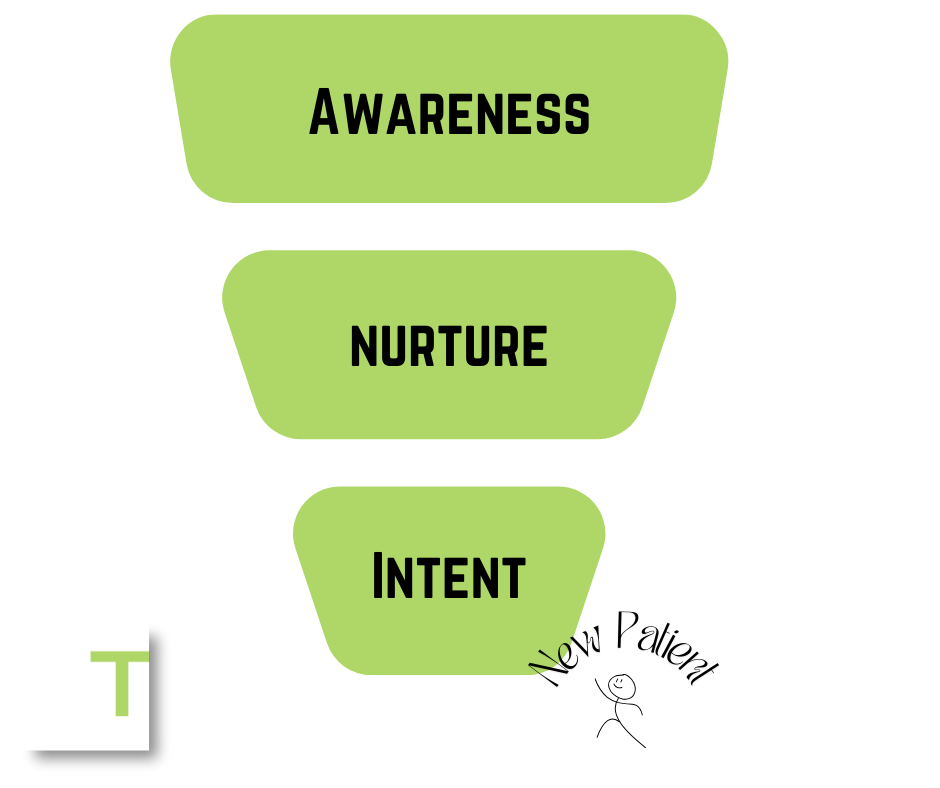This Trojan Today Classic was originally published in June of 2016 in Trojan Today.
There are so many online tactics for attracting website visitors that even those with marketing savvy can get overwhelmed. Consider this funnel, the brainchild of Ryan Wilson of FiveFifty Digital Marketing, to simplify the possibilities:
Awareness
The top and largest section of Wilson’s funnel is awareness. For new and growing practices, the immediate goal is to increase awareness of the practice’s offerings. The number of people who know about the practice has not yet reached critical mass, but people will soon learn about the practice with tactics of video, contextual ads, and behavioral ads.
Some dentists are under the false impression they must have video on their website in order to be highly visible by search engines. While video might help, there are plenty of other more efficient tools to help with exposure. Video production can be quite costly — $10,000 or more for a quality 3-minute spot — so tread lightly.
Contextual and behavioral ads are colorfully designed, sometimes animated or flashy ads. Contextual ads appear on websites that have a context closely linked to your practice’s offering. Behavioral ads appear on websites that match the online profile, or behavior, of those most likely to become patients.
Nurture
Consider the next concept in Wilson’s funnel: the pool of potential patients you can nurture into the practice. These are patients who may have a need in the future or who have lapsed in treatment but will need to return one day. While they are not ready to make an appointment today, they are likely to make an appointment in the next six months.
Nurture tactics help the practice show up in the right place at the right time. They most often include retargeting ads, Facebook ads, Facebook promoted posts, and email campaigns.
Retargeting ads include more than text. Often called banner ads, they are colorfully designed, sometimes animated or flashy ads that follow people around the web. Let’s say a potential patient visits your website, but wanders off to a number of different sites. A banner ad for your practice can appear atop multiple pages on those other sites to keep your practice top-of-mind for the potential patient.
Facebook ads work in a similar manner, appearing in the newsfeeds of people who are likely to visit your practice one day. This visibility nurtures the potential patient to think of you when the time is right.
Daily posting on your Facebook page is the unpaid way to capture this mindshare and can be equally effective. As with Search Engine Optimization (SEO) and Google AdWords, a one-two punch can pack the biggest bang.
Email campaigns are a great do-it-yourself option to nurture potential patients to take the next step. Push it beyond the typical practice newsletter. Create a series of emails that reflect your practice and have a clever twist.
Intent
In Wilson’s funnel, the bottom and smallest area is packed full of people who seek a practice like yours. It’s in every practice’s best interest to make a concerted effort to reach the people who already have intent to see a dentist. “Right this very moment there are potential patients who already need your care,” explains Wilson. “It’s just a matter of scooping them up.”
These are the folks who reside in the intent section of the funnel. They understand they have a dental need, they know they have to seek out a dentist, and they are ready to make an appointment once they find the right dental practice. This is low-hanging fruit. It’s comparatively inexpensive to get intentional people to take that last step of calling for the appointment.
Intent tactics invite those people into the practice, and the tactics typically include SEO and Google AdWords.
SEO drives websites to the top of the “organic” listings through methods of enriching website content. Google, Yahoo, and Bing crawl the web continuously to search out the most robust websites and present them as top choices for the keywords being searched.
SEO used to be a simple process of stuffing key words into a website and bolstering website headings with highly searched terms. Today it is a far more complex undertaking. On average, Google changes its search algorithm every two days.
The more relevant the content and the more regular updates your website has, the more robust it appears to the search engines, and the higher it climbs in the search results. SEO for your website is like car maintenance; the tasks for upkeep continue over the lifetime of the vehicle.
Google AdWords is simply an online auction. Competing dental practices essentially outbid each other so their website ad shows most often. Each keyword, such as “Austin orthodontist,” is given a dollar value, and the highest bidder’s ad shows up first atop the page. The charge is triggered not when the ad shows but when someone clicks on the ad. Hence, the term pay-per-click advertising. This is where Google makes its money, by making it easy for small business owners to set up and manage their own campaigns.
Easy to set up and manage, sure. But it’s more complicated to create a campaign that will drive results. A good search strategist will help select highly searched words and terms of a reasonable cost and that are most likely to convert clicks into paying patients. A strong ad leads not to the website homepage but to a relevant landing page that echoes the offer in the ad. The landing page increases the likelihood the potential patient will convert, or take the next step, such as call or make an appointment.
It doesn’t matter whether you are more apt to stick to the organic search results or to click on the ads on the Google results. It matters only how your potential patients behave online.
Each part of the funnel feeds into the next. Wilson advises, “If you have strong website traffic but potential patients are not filling out the online form or calling in, that indicates the need to move people from ‘nurture’ to ‘intent’. If your website traffic is low, that indicates a need for more ‘awareness’.”
Some practices benefit from regularly running one or two tactics in each area of the funnel. Many simply stick to nurture tactics to maintain the status quo of patient traffic through top-of-mind awareness.
“Eventually you will get to the point where you will have reached the number of people that you can affect,” he explains. “Then you run more awareness marketing to open up the funnel. Work from the bottom up.
“There’s only so much you can do online,” he continues.
“No one will go online and book a $50,000 implant case, but there are other activities to optimize like ‘Share your email address,’ or ‘Like us on Facebook.’ Focus on those and move visitors down the funnel.”
The great thing about online efforts is they are highly measurable. Be sure to set up Google Analytics to track website traffic. Run and analyze monthly Analytics reporting to see positive trends and make the most of your online marketing efforts.
With online promotion, so much of the decision happens before the patient even contacts the practice. Work the funnel to make it easy for potential patients to pick your practice.
Wendy O’Donovan Philips is CEO of Big Buzz in Denver, CO.
FMI: www.bigbuzinc.com, or (720) 350-4484

